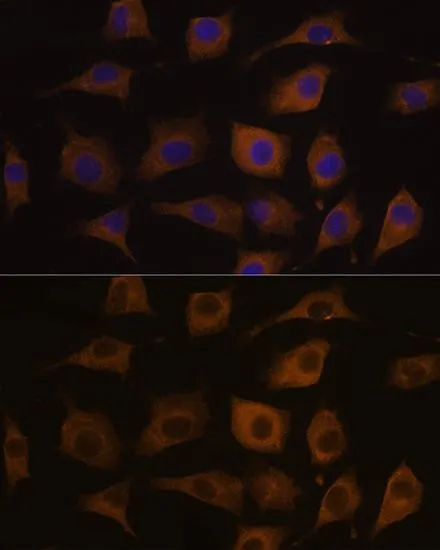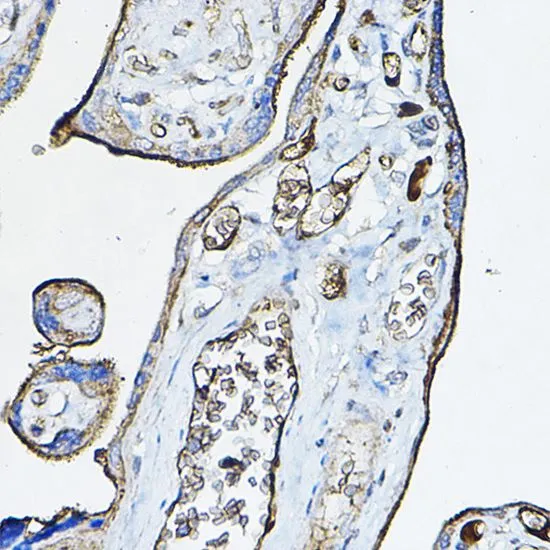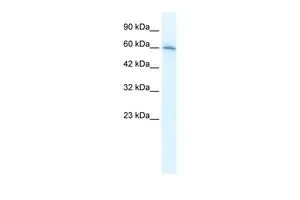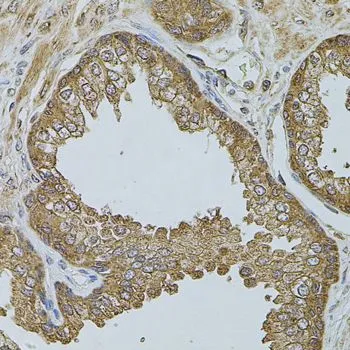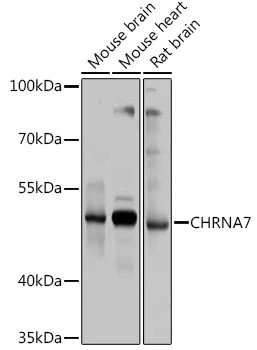
WB analysis of various sample lysates using GTX64511 AChR alpha 7 antibody. Dilution : 1:1000 Loading : 25microg per lane
AChR alpha 7 antibody
GTX64511
ApplicationsImmunoFluorescence, Western Blot, ImmunoCytoChemistry, ImmunoHistoChemistry, ImmunoHistoChemistry Paraffin
Product group Antibodies
TargetCHRNA7
Overview
- SupplierGeneTex
- Product NameAChR alpha 7 antibody
- Delivery Days Customer9
- Application Supplier NoteWB: 1:500 - 1:2000. ICC/IF: 1:50 - 1:200. IHC-P: 1:50 - 1:200. *Optimal dilutions/concentrations should be determined by the researcher.Not tested in other applications.
- ApplicationsImmunoFluorescence, Western Blot, ImmunoCytoChemistry, ImmunoHistoChemistry, ImmunoHistoChemistry Paraffin
- CertificationResearch Use Only
- ClonalityPolyclonal
- ConjugateUnconjugated
- Gene ID1139
- Target nameCHRNA7
- Target descriptioncholinergic receptor nicotinic alpha 7 subunit
- Target synonymsCHRNA7-2, NACHRA7, nAChR7, neuronal acetylcholine receptor subunit alpha-7, a7 nicotinic acetylcholine receptor, alpha 7 neuronal nicotinic acetylcholine receptor, alpha-7 nicotinic cholinergic receptor subunit, cholinergic receptor, nicotinic alpha 7, cholinergic receptor, nicotinic, alpha 7 (neuronal), cholinergic receptor, nicotinic, alpha polypeptide 7, neuronal acetylcholine receptor protein, alpha-7 chain, nicotinic acetylcholine receptor subunit alpha-7
- HostRabbit
- IsotypeIgG
- Protein IDP36544
- Protein NameNeuronal acetylcholine receptor subunit alpha-7
- Scientific DescriptionThe nicotinic acetylcholine receptors (nAChRs) are members of a superfamily of ligand-gated ion channels that mediate fast signal transmission at synapses. The nAChRs are thought to be hetero-pentamers composed of homologous subunits. The proposed structure for each subunit is a conserved N-terminal extracellular domain followed by three conserved transmembrane domains, a variable cytoplasmic loop, a fourth conserved transmembrane domain, and a short C-terminal extracellular region. The protein encoded by this gene forms a homo-oligomeric channel, displays marked permeability to calcium ions and is a major component of brain nicotinic receptors that are blocked by, and highly sensitive to, alpha-bungarotoxin. Once this receptor binds acetylcholine, it undergoes an extensive change in conformation that affects all subunits and leads to opening of an ion-conducting channel across the plasma membrane. This gene is located in a region identified as a major susceptibility locus for juvenile myoclonic epilepsy and a chromosomal location involved in the genetic transmission of schizophrenia. An evolutionarily recent partial duplication event in this region results in a hybrid containing sequence from this gene and a novel FAM7A gene. Alternative splicing results in multiple transcript variants. [provided by RefSeq, Feb 2012]
- Storage Instruction-20°C or -80°C,2°C to 8°C
- UNSPSC12352203
References
- Xu Y, Cao K, Guo B, et al. Lowered levels of nicotinic acetylcholine receptors and elevated apoptosis in the hippocampus of brains from patients with type 2 diabetes mellitus and db/db mice. Aging (Albany NY). 2020,12(14):14205-14218. doi: 10.18632/aging.103435Read this paper
- Ren JM, Zhang SL, Wang XL, et al. Expression levels of the α7 nicotinic acetylcholine receptor in the brains of patients with Alzheimer's disease and their effect on synaptic proteins in SH-SY5Y cells. Mol Med Rep. 2020,22(3):2063-2075. doi: 10.3892/mmr.2020.11253Read this paper
- Zeng XX, Deng J, Xiang J, et al. Protections against toxicity in the brains of rat with chronic fluorosis and primary neurons exposed to fluoride by resveratrol involves nicotinic acetylcholine receptors. J Trace Elem Med Biol. 2020,60:126475. doi: 10.1016/j.jtemb.2020.126475Read this paper

